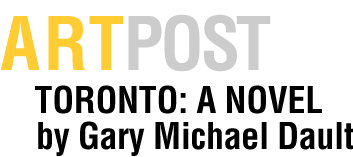TORONTO: A NOVEL—Chapter 47
He did, yes. As unappetizing as Michael felt the experience might become, he really did want to look at some of Homer Rubik’s paintings. There was something uncanny about them. They looked like Old Master paintings—like greatly reduced versions of Titians, Tintorettos, Rembrandts, Caravaggios. It was all crazy but oddly compelling to gaze upon. And anyhow how in hell did this semi-bestial short-order cook learn to paint like this? With this much technical skill?
And the thing was, Homer didn’t just paint small copies of Old Master paintings. He didn’t in fact, copy them at all. He never painted replicas. What he did was to paint new pictures that evoked the Old Masters, that were carefully painted in the traditional, historical ways.
But the creepy thing about Homer’s paintings—despite the wondrous skill with which they were made—was that their content was always horribly awry. There was never any serenity in Homer’s paintings, never any grace. If he set painting a Saint George slaying a dragon, his dragon was sure to be depicted slaying Saint George.
One painting, a big one for Homer, depicted the birth of Venus—a golden, tumble-haired Venus standing naked and assured on a giant clam shell now washed ashore. She was pretty much as she was in the Botticelli original, except for the fact that right behind her, emerging from the pretty Adriatic waves, was an enormous octopus waving its tentacles threateningly in her direction. Indeed, as Michael noticed upon closer inspection, one sinister tentacle had already encircled the goddess’s left ankle.
Homer noticed Michael staring at his Venus.
“Pretty hot, huh?” he said.
“Disturbing” Michael replied.
“Birth of Venus,” Homer grumbled.
“Looks like her birth and imminent demise, all at the same time.”
Homer gave a grunt and walked off to the kitchen. He was gone for over two minutes, at which time he reappeared carrying two cans of Coke and a Lost Dog poster. He handed Michael a can and held up the poster.
“This is what I made for Bliss, to help find Fish,” he told Michael. It was the poster with the colour photo-copy of Lorenzo Lotto’s Judith clutching the severed head of Holofernes—with Bliss’s cell phone number on it. And no photo of Fish anywhere. The poster was Fish-free.
“How did you expect Bliss to get Fish back if you didn’t show what the stupid dog looked like?” Michael asked.
“I don’t care if she ever gets Fish back.” Homer said.
“Yeh, that’s pretty clear. But so why make the poster at all?”
“I didn’t want to piss off Bliss too bad,” Homer told him.
“You cared what she’d think?”
Homer grinned lasciviously.
“I like to get laid,” he told Michael.
Violet Dollop had now begun to write in earnest. She consigned her scribblings to coil–bound notebooks, which she bought, a dozen at a time, at the Dollar Store in a nearby shopping plaza.
She usually wrote, once Tom left for the office, on the kitchen table—just after she cleared away the breakfast things.
It was lovely and quiet after Tom’s departure. But while she was grateful for the quiet, her heart went out to Tom, who, given the company’s recently relocating their offices to somewhere in the wilds of Don Mills, now had to inch up the Don Valley Parkway every morning and inch back down again at the end of the day. Tonight, when he got home, she was going to ask him what he did—what he thought about in those three hours of inchworm transition-time. She supposed he listened to the radio. CFRB? CHUM-FM? Some Indie station or other? She hardly imagined he listened to the CBC. She wondered if he ever just sat at the wheel of the car, glassy-eyed, reading the licence plates of the cars in front of him. Se used to do that sometimes when they were stuck in traffic together. She smiled to herself. The couple that sits idling together stays together. That could be a bumper sticker.
Lately, whenever she was in the car with Tom, and they were in traffic jams—and when were they not?—she had begun to study the design of automobile tail lights. They were weirdly similar—despite the make of car—and yet eerily distinctive.
She found it surprisingly absorbing to note the way the red part of the fixture—the stoplight—shared a housing with the clear part—the back-up light—and how the car’s designers had decided upon and negotiated the relative authority of each light’s function. Surely stopping (red) was a more urgent signal than merely backing up (the clear lamp)? She could remember when cars didn’t even have back-up lamps. She could also remember when trucks didn’t go beep-beep-beep when they reversed. She often wondered whether any truck’s alarmed beeping had really ever prevented an accident or an injury?
But it was tail lights she was really interested in. She found them fascinating enough that she had decided to attempt an essay about them. She was intrigued how, of late, tail lights had been mounting up the back of cars and framing the rear window and even, sometimes, venturing out onto over the car’s’ rear hatch, up near the roof. She was astonished at how bright they had become. Tail lights today were almost as blinding as headlights.
She sat at the kitchen table, opened a notebook, took her new fountain pen from its case, out on the kettle to make herself a cup of tea, and began to write. She had eight full hours before Tom would be home again.

